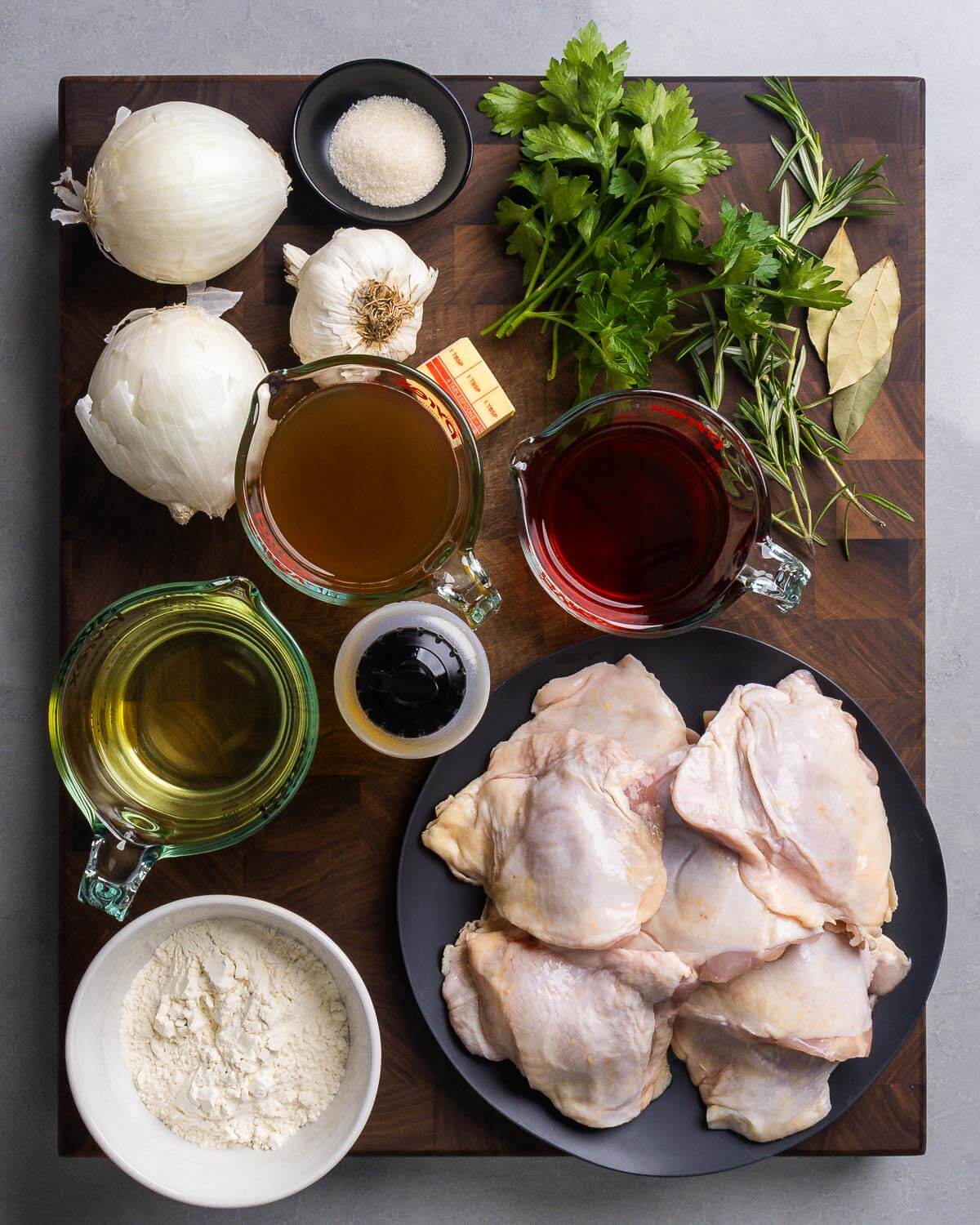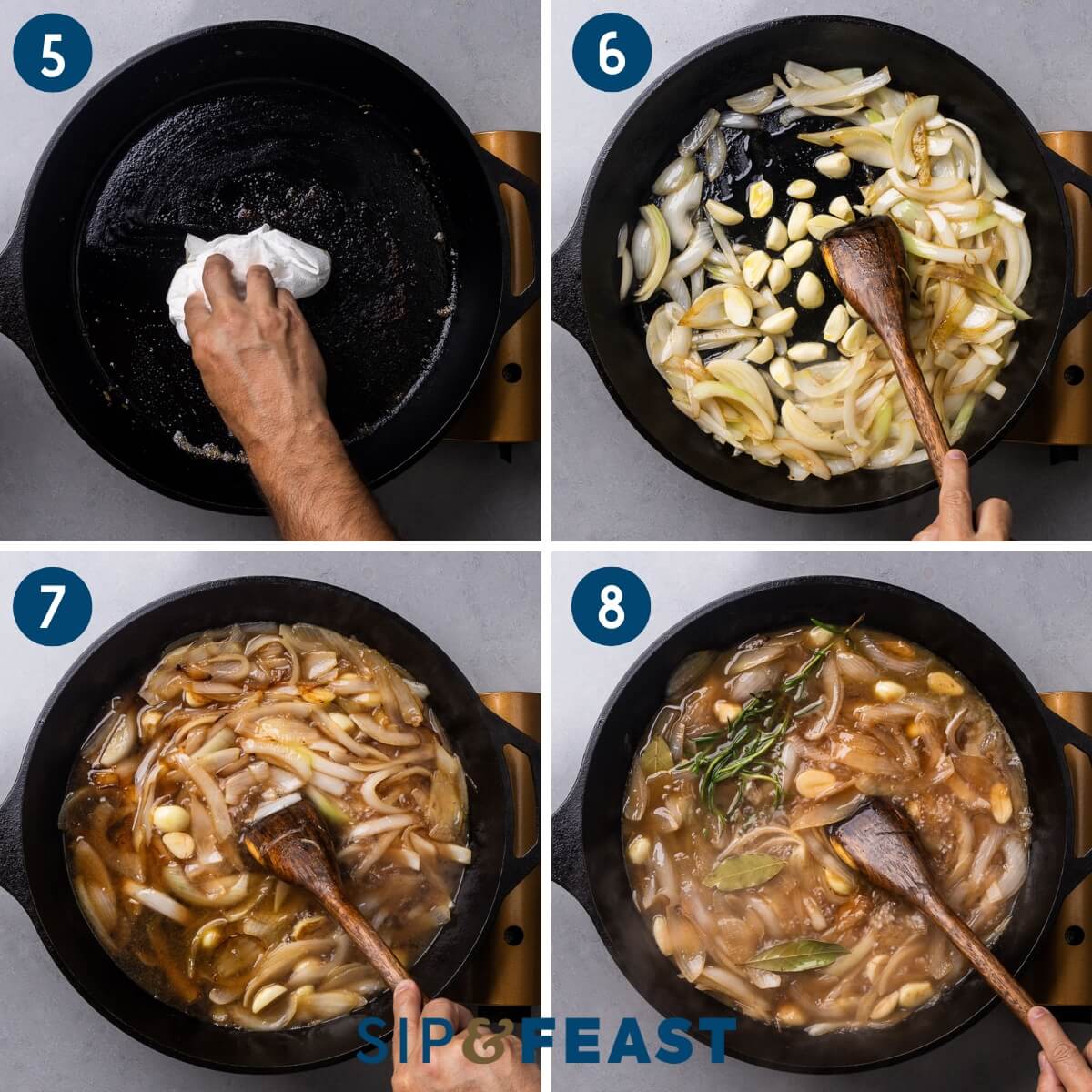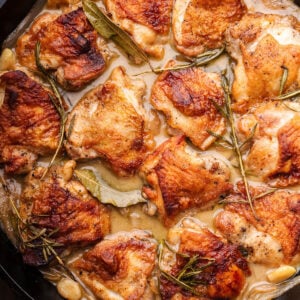Italian-Style Vinegar Chicken combines chicken thighs that are seared and braised until tender in a tasty vinegar sauce with onions, garlic, parsley, and herbs. It’s easy to make so it’s great for weeknights, but special enough for gatherings or Sunday dinner.

This post may contain affiliate links. Our disclosure policy.
Though Vinegar Chicken has a similar flavor profile to Chicken Scarpariello, it’s easier to prepare making it an excellent choice for busy nights, and is right up there with my one-pan easy Greek lemon chicken and potatoes.
Since this dish braises for roughly 35 minutes in the oven, that leaves you plenty of time to make a few side dishes as well.
I love to serve vinegar chicken over creamy polenta with a side of roasted broccoli.
Recipe Ingredients
All ingredients for this recipe are shown in the pic below and special notes are made in this bulleted list to assist you.

- Chicken. I’ve found that bone-in chicken thighs yield the best flavor and that’s what I’m using for this recipe. That being said, you can 100% use boneless skinless chicken thighs and achieve great results.
- Vinegar. Red wine vinegar is the vinegar of choice for this dish. I suggest buying red wine vinegar in 1-gallon jugs from the grocery store – it’s more economical.
- Wine. Use a dry white wine, such as Sauvignon Blanc or Pinot Grigio for vinegar chicken.
See the recipe card for full information on ingredients and quantities.
How to make it
Each number corresponds to the numbered written steps below.
- Preheat the oven to 350f and set the rack to the middle level. Slice 2 large white onions, root to stem, into 1/4″ thick slices. Halve 12 cloves of garlic and mince 1/4 cup of flat-leaf Italian parsley. Cube 3 tablespoons of butter and place in the fridge to stay cold until the end. Trim any overhanging fat from 4 pounds of chicken thighs, then dry them well with paper towels. Distribute 2 teaspoons of Diamond Crystal kosher salt and 1 teaspoon of black pepper across the chicken.
- In a shallow plate, tray, or in a plastic bag, place 1 cup of all-purpose flour and dredge the chicken in the flour, shaking gently to remove any excess, before placing on a parchment paper lined baking sheet.

- Heat a large oven-safe pan to medium heat with 1/4 inch of neutral oil. Once the oil is shimmering, add the chicken thighs skin-side-down.
- Sear the thighs until golden, about 5 minutes, then flip and sear on the other side for about 3 minutes. Place the seared chicken onto a paper towel lined plate to drain and repeat with the remaining pieces, working in batches to not overcrowd the pan.
- Pour out the frying oil and wipe down the pan.
- Add 1/4 cup of olive oil along with the onions and a pinch of salt. Saute the onions for 7-10 minutes or until soft adding a splash of water as needed if they begin to burn. Once soft, add the garlic and cook for another 3-5 minutes or until fragrant and golden.

- Add 1 cup of red wine vinegar, 1 1/2 cups of dry white wine, and 1 tablespoon of granulated sugar, turn the heat to high, and use a wooden spoon to gently dislodge any brown bits from the pan. Boil for 5 minutes or until the liquid reduces by half.
- Add 1 1/4 cups of low-sodium or homemade chicken stock along with 3 sprigs of rosemary and 3 large bay leaves and bring to a boil.
- Once boiling, turn off the heat and add the chicken pieces, skin-side-up. Cover the pan tightly with foil and place in the oven to bake for 20 minutes. Then remove the foil and cook the chicken thighs until they reach an internal temperature of 185-195f, about 10-15 minutes. Use an instant-read thermometer to ensure accuracy.
- Remove the pan from the oven and place the chicken pieces on a platter. Tent with foil so they stay warm.

- Check the consistency of the sauce and if it’s too thin, place the pan on a burner and bring to a boil for a few minutes to thicken. Once satisfied with the sauce, turn off the heat and remove the rosemary branches and bay leaves. Add the parsley and whisk in one cube of butter at a time to emulsify. Taste test the sauce and season with salt and pepper if needed.
- Pour the sauce over the chicken and serve. Enjoy!
Top tips
- Use homemade chicken stock. Whenever possible, I suggest using homemade stock. It gives you greater control over the sodium levels in your dish and has a better taste than boxed stock. A good second choice would be to use a stock made from chicken base, such as Better Than Bouillon brand.
- Use one pan for easier cleanup. To make vinegar chicken even easier, I recommend using an oven-safe pan for the entire process. A 14″ stainless steel pan works well, as would a large cast iron pan.
- Be creative. While I opted to use rosemary and bay leaves for this version of vinegar chicken, feel free to be creative! I recently filmed a Patreon video for this same dish where I omitted the rosemary and used cherry peppers instead and it was phenomenal!

Want To Save This Recipe?
More chicken recipes
If you’re looking for some great ways to use chicken thighs, I think you’ll love these recipes!
If you’ve enjoyed this Italian-Style Vinegar Chicken Recipe or any recipe on this site, give it a 5-star rating and tell us about it in the comments below.
We strive to satisfy a number of learning styles. If you are someone who prefers to learn by watching, you can find most of our recipes on YouTube and our Facebook Page.
For more never-before-seen FULL MEAL RECIPE VIDEOS, become a Patreon member today!
Italian-Style Vinegar Chicken

Ingredients
- neutral oil for frying the chicken
- 4 pounds chicken thighs trimmed of overhanging fat
- 2 teaspoons Diamond Crystal kosher salt
- 1 teaspoon black pepper
- 1 cup all-purpose flour for dredging only
- 1/4 cup olive oil
- 2 large white onions sliced root to stem 1/4" thick
- 12 cloves garlic halved
- 1 cup red wine vinegar
- 1 1/2 cups dry white wine
- 1 tablespoon granulated sugar
- 1 1/4 cups low-sodium chicken stock
- 3 sprigs rosemary
- 3 large bay leaves
- 3 tablespoons unsalted cold butter cubed
- 1/4 cup minced flat-leaf Italian parsley
Want To Save This Recipe?
Instructions
- Preheat oven to 350f and set the rack to the middle level.
- Dry off the chicken pieces with paper towels and season with salt and pepper. Dredge the chicken in flour, shake off the excess, and place onto a parchment paper lined baking sheet.
- Heat a large oven-safe pan to medium heat with a 1/4 inch of neutral oil (vegetable, avocado, etc). Once the oil is shimmering, add the chicken pieces skin side down and sear until golden (about 5 minutes) then flip and cook for another 3 minutes or so. Place the seared chicken onto a plate and repeat with the remaining pieces, working in batches to not overcrowd the pan.
- Pour out the frying oil and wipe down the pan. Add the olive oil along with the onions and a pinch of salt. Saute the onions until soft (about 7-10 minutes), adding a splash of water along the way if they start to burn. Once they are soft, add the garlic and cook for another 3-5 minutes or until fragrant and golden.
- Next, add in the white wine, vinegar, and sugar and turn heat to high. With a wooden spoon scrape the bottom of the pan to remove any brown bits. Boil for 5 minutes to reduce the liquid by about half.
- Add the chicken stock, rosemary, and bay leaves and bring to a boil. Once boiling turn off the heat and add in the chicken pieces, skin side up. Cover the pan tightly with foil and place in the oven. Bake for 20 minutes then remove the foil and continue to cook until the chicken thighs reach at least 185-195f internally after checking with an instant-read thermometer (about 10-15 minutes).
- Remove the pan from the oven and place the chicken pieces on a platter tented with foil to keep warm. Check the consistency of the sauce. If it is too thin for your liking, place the pan on a burner and bring to a boil for a few minutes to thicken.
- Once satisfied, turn off the heat and remove the rosemary and bay leaves. Mix in the parsley. Whisk in one cube of butter at a time. Taste test the sauce and season with salt and pepper if required. Pour the sauce over the chicken and serve. Enjoy!
Notes
- Chicken thighs are juicier and are far more forgiving to cook with. They are recommended for this dish. You can use either bone-in, skin-on thighs or boneless-skinless. For boneless-skinless use 2.5-3 pounds instead.
- If the sauce is a little thin at the end, follow step 7, but it’s often not required.
- Leftovers can be saved for up to 3 days in the fridge and can be reheated covered with foil in the oven at 325f until warmed through.
Nutrition
Nutrition information is automatically calculated, so should only be used as an approximation.
Follow Me







Great recipe! I have also used prosecco vinegar (or champagne vinegar). I don’t generally love sparkling wines, but using fizzy wine vinegar does add a nice little “twist” to this already superb recipe. Thanks for posting this! (and thanks for all the recipes you have posted over the years)
So glad you enjoyed, Dave!
I’m looking to add a Madein 14” skillet like yours to my kitchen. It’s not on their website. Any suggestions?
Hi Jay, Jim has a similar 14″ pan he uses in the shop that’s linked here on the website.